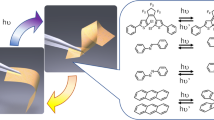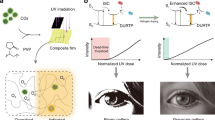Abstract
PHOTOREFRACTIVE materials are of considerable interest for the development of all-optical devices1. The photoref ractive effect appears in materials that exhibit an electric-field-dependent refractive index and that are photosensitive, such that the spatial distribution of photogenerated charge carriers is modified on irradiation with light. The diffraction pattern formed by the interference of two coherent light beams within such a material generates a non-uniform internal electric field that in turn modulates the refractive index. The resulting refractive-index pattern forms a grating that can diffract light and thereby give rise to two-beam coupling, whereby one of the writing beams gains energy at the expense of the other—a property that can be exploited in photonic devices. Although the best photorefractive materials currently available are inorganic crystals such as LiNbO3, there is considerable interest in the development of photorefractive polymers2–8, owing to their structural flexibility, ease of processing and lower cost. We describe here a polymer composite with excellent photorefractive properties. We have achieved a diffraction efficiency approaching 100% and a net two-beam coupling gain of more than 200 cm–1, making these polymeric materials suitable for immediate application in areas such as dynamic holographic storage and optical information processing1.
This is a preview of subscription content, access via your institution
Access options
Subscribe to this journal
Receive 51 print issues and online access
$199.00 per year
only $3.90 per issue
Buy this article
- Purchase on Springer Link
- Instant access to full article PDF
Prices may be subject to local taxes which are calculated during checkout
Similar content being viewed by others
References
Günter, P. & Huignard, J. P. Photorefractive Materials and Their Applications Vols 1 & 2 (Springer, Berlin, 1988 & 1989).
Ducharme, S., Scott, J. C., Twieg, R. J. & Moerner, W. E. Phys. Rev. Lett. 66, 1846–1849 (1991).
Tamura, K., Padias, A. B., Hall, H. K. Jr & Peyghambarian, N. Appl. Phys. Lett. 60, 1803–1805 (1992).
Cui, Y., Zhang, Y., Prasad, P. N., Schildkraut, J. S. & Williams, D. J. Appl. Phys. Lett. 61, 2132–2134 (1992).
Kippelen, B., Tamura, K., Peyghambarian, N., Padias, A. B. & Hall, H. K. Jr Phys. Rev. B48, 10710–10717 (1992).
Donkers, M. C. J. M. et al. Opt. Lett. 18, 1044–1046 (1993).
Kippelen, B. et al. Electron. Lett. 29, 1873–1874 (1993).
Liphard, M. et al. Science 263, 367–369 (1994).
Kukhtarev, N. V., Markov, V. B., Odulov, S. G., Soskin, M. S. & Vinetskii, V. L. Ferroelectrics 22, 949–960 (1979).
Weiser, G. Phys. Status Solidi A18, 347–359 (1973).
Kogelnik, H. Bell System Tech. J. 48, 2909–2947 (1969).
Singer, K. D., Kuzyk, M. G. & Sohn, J. E. J. Opt. Soc. Am. B4, 968–976 (1987).
Wu, J. W. J. Opt. Soc. Am. B8, 142–152 (1991).
Moerner, W. E., Silence, S. M., Hache, F. & Bjorklund, G. C. J. Opt. Soc. Am. B11, 320–330 (1994).
Author information
Authors and Affiliations
Rights and permissions
About this article
Cite this article
Meerholz, K., Volodin, B., Sandalphon et al. A photorefractive polymer with high optical gain and diffraction efficiency near 100%. Nature 371, 497–500 (1994). https://doi.org/10.1038/371497a0
Received:
Accepted:
Issue Date:
DOI: https://doi.org/10.1038/371497a0
This article is cited by
-
Simulation of optical radiation force distribution in interference patterns and necessary conditions for chiral structure formation on dielectrics
Scientific Reports (2022)
-
A High Energy Density Azobenzene/Graphene Oxide Hybrid with Weak Nonbonding Interactions for Solar Thermal Storage
Scientific Reports (2019)
-
Chlorine (Cl) - Substituted Carbazole Based A-π-D-π-a Push-Pull Chromophores as Aggregation Enhanced Emission (AEE) Active Viscosity Sensors: Synthesis, DFT and NLO Approach
Journal of Fluorescence (2019)
-
DFT/TD-DFT study on halogen doping and solvent contributions to the structural and optoelectronic properties of poly[3,6-carbazole] and poly[indolo(3,2-b)-carbazole]
Structural Chemistry (2018)
-
Effects of C60 on the Glass Transition Temperature of Carbazole-based Photorefractive Polyphosphazenes
Journal of Wuhan University of Technology-Mater. Sci. Ed. (2018)
Comments
By submitting a comment you agree to abide by our Terms and Community Guidelines. If you find something abusive or that does not comply with our terms or guidelines please flag it as inappropriate.



